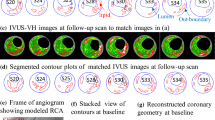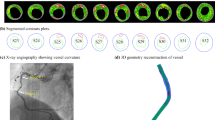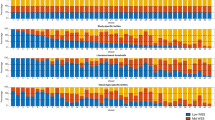Abstract
Atherosclerotic plaque progression is believed to be associated with mechanical stress conditions. Patient follow-up in vivo intravascular ultrasound coronary plaque data were acquired to construct fluid–structure interaction (FSI) models with cyclic bending to obtain flow wall shear stress (WSS), plaque wall stress (PWS) and strain (PWSn) data and investigate correlations between plaque progression measured by wall thickness increase (WTI), cap thickness increase (CTI), lipid depth increase (LDI) and risk factors including wall thickness (WT), WSS, PWS, and PWSn. Quarter average values (n = 178–1016) of morphological and mechanical factors from all slices were obtained for analysis. A predictive method was introduced to assess prediction accuracy of risk factors and identify the optimal predictor(s) for plaque progression. A combination of WT and PWS was identified as the best predictor for plaque progression measured by WTI. Plaque WT had best overall correlation with WTI (r = −0.7363, p < 1E−10), cap thickness (r = 0.4541, p < 1E−10), CTI (r = −0.4217, p < 1E−8), LD (r = 0.4160, p < 1E−10), and LDI (r = −0.4491, p < 1E−10), followed by PWS (with WTI: (r = −0.3208, p < 1E−10); cap thickness: (r = 0.4541, p < 1E−10); CTI: (r = −0.1719, p = 0.0190); LD: (r = −0.2206, p < 1E−10); LDI: r = 0.1775, p < 0.0001). WSS had mixed correlation results.




Similar content being viewed by others
References
Cardoso, L., and S. Weinbaum. Changing views of the biomechanics of vulnerable plaque rupture: a review. Ann. Biomed. Eng. 42(2):415–431, 2014.
Fernández-Ortiz, A., L. J. Jiménez-Borreguero, J. L. Peñalvo, J. M. Ordovás, A. Mocoroa, L. Fernández-Friera, M. Laclaustra, L. García, J. Molina, J. M. Mendiguren, B. López-Melgar, V. M. de Vega, J. C. Alonso-Farto, E. Guallar, H. Sillesen, J. H. Rudd, Z. A. Fayad, B. Ibañez, G. Sanz, and V. Fuster. The Progression and Early detection of Subclinical Atherosclerosis (PESA) study: rationale and design. Am. Heart J. 166(6):990–998, 2013.
Fitzmaurice, G. M., N. M. Laird, and J. H. Ware. Applied Longitudinal Analysis. Hoboken, NJ: Wiley-Interscience, 2004.
Fleg, J. L., G. W. Stone, Z. A. Fayad, J. F. Granada, T. S. Hatsukami, F. D. Kolodgie, J. Ohayon, R. Pettigrew, M. S. Sabatine, G. J. Tearney, S. Waxman, M. J. Domanski, P. R. Srinivas, and J. Narula. Detection of high-risk atherosclerotic plaque: report of the NHLBI working group on current status and future directions. JACC Cardio Imaging. 5(9):941–955, 2012.
Friedman, M. H., C. B. Bargeron, O. J. Deters, G. M. Hutchins, and F. F. Mark. Correlation between wall shear and intimal thickness at a coronary artery branch. Atherosclerosis 68:27–33, 1987.
Friedman, M. H., R. Krams, and K. B. Chandran. Flow interactions with cells and tissues: cardiovascular flows and fluid–structure interactions. Ann. Biomed. Eng. 38:1178–1187, 2010.
Fuster, V. The vulnerable atherosclerotic plaque: understanding, identification, and modification. In: AHA Monograph Series, edited by V. Fuster, J. F. Cornhill, R. E. Dinsmore, J. T. Fallon, W. Insull, P. Libby, S. Nissen, M. E. Rosenfeld, and W. D. Wagner. Armonk, NY: Futura Publishing, 1998.
Holzapfel, G. A., J. J. Mulvihill, E. M. Cunnane, and M. T. Walsh. Computational approaches for analyzing the mechanics of atherosclerotic plaques: a review. J. Biomech. 47(4):859–869, 2014.
Holzapfel, G. A., G. Sommer, and P. Regitnig. Anisotropic mechanical properties of tissue components in human atherosclerotic plaques. J. Biomech. Eng. 126(5):657–665, 2004.
Huang, X., C. Yang, C. Yuan, F. Liu, G. Canton, J. Zheng, P. K. Woodard, G. A. Sicard, and D. Tang. Patient-specific artery shrinkage and 3D zero-stress state in multi-component 3D FSI models for carotid atherosclerotic plaques based on in vivo MRI data. Mol. Cell Biomech. 6(2):121–134, 2009.
Ku, D. N., D. P. Giddens, C. K. Zarins, and S. Glagov. Pulsatile flow and atherosclerosis in the human carotid bifurcation: positive correlation between plaque location and low and oscillating shear stress. Arteriosclerosis. 5:293–302, 1985.
Kural, M. H., M. C. Cai, D. Tang, T. Gwyther, J. Zheng, and K. L. Billiar. Planar biaxial characterization of diseased human coronary and carotid arteries for computational modeling. J. Biomech. 45(5):790–798, 2012.
Le Floc’h, S., G. Cloutier, Y. Saijo, G. Finet, S. K. Yazdani, F. Deleaval, G. Rioufol, R. I. Pettigrew, and J. Ohayon. A four-criterion selection procedure for atherosclerotic plaque elasticity reconstruction based on in vivo coronary intravascular ultrasound radial strain sequences. Ultrasound Med. Biol. 38(12):2084–2097, 2012.
Loree, H. M., R. D. Kamm, R. G. Stringfellow, and R. T. Lee. Effects of fibrous cap thickness on peak circumferential stress in model atherosclerotic vessels. Circ. Res. 71:850–858, 1992.
Ohayon, J., G. Finet, A. M. Gharib, D. A. Herzka, P. Tracqui, et al. Necrotic core thickness and positive arterial remodeling index: emergent biomechanical factors for evaluating the risk of plaque rupture. Am. J. Physiol. Heart Circ. Physiol. 295:H717–H727, 2008.
Pinherio, J. C., and D. M. Bates. Mixed Effects Models in S and S-PLUS. New York: Springer, 2000.
Richardson, P. D. Biomechanics of plaque rupture: progress, problems, and new frontiers. Ann. Biomed. Eng. 30(4):524–536, 2002.
Richardson, P. D., M. J. Davies, and G. V. Born. Influence of plaque configuration and stress distribution on fissuring of coronary atherosclerotic plaques. Lancet 2(8669):941–944, 1989.
Samady, H., P. Eshtehardi, M. C. McDaniel, J. Suo, S. S. Dhawan, C. Maynard, L. H. Timmins, A. A. Quyyumi, and D. P. Giddens. Coronary artery wall shear stress is associated with progression and transformation of atherosclerotic plaque and arterial remodeling in patients with coronary artery disease. Circulation 124:779–788, 2011.
Schall, R. Estimation in generalized linear models with random effects. Biometrika 78:719–727, 1991.
Stone, P. H., S. Saito, S. Takahashi, Y. Makita, S. Nakamura, T. Kawasaki, A. Takahashi, T. Katsuki, S. Nakamura, A. Namiki, A. Hirohata, T. Matsumura, S. Yamazaki, H. Yokoi, S. Tanaka, S. Otsuji, F. Yoshimachi, J. Honye, D. Harwood, M. Reitman, A. U. Coskun, M. I. Papafaklis, and C. L. Feldman. Prediction of progression of coronary artery disease and clinical outcomes using vascular profiling of endothelial shear stress and arterial plaque characteristics: the PREDICTION Study. Circulation 126(2):172–181, 2012.
Tang, D., R. D. Kamm, C. Yang, J. Zheng, G. Canton, R. Bach, X. Huang, T. S. Hatsukami, J. Zhu, G. Ma, A. Maehara, G. S. Mintz, and C. Yuan. Image-based modeling for better understanding and assessment of atherosclerotic plaque progression and vulnerability: data, modeling, validation, uncertainty and predictions. J. Biomech. 47(4):834–846, 2014.
Tang, D., Z. Teng, G. Canton, C. Yang, M. Ferguson, X. Huang, J. Zheng, P. K. Woodard, and C. Yuan. Sites of rupture in human atherosclerotic carotid plaques are associated with high structural stresses: an in vivo MRI-based 3D fluid–structure interaction study. Stroke 40(10):3258–3263, 2009. Featured article on MDlinx.com.
Tang, D., C. Yang, G. Canton, Z. Wu, T. S. Hatsukami, and C. Yuan. Correlations between carotid plaque progression and mechanical stresses change sign over time: a patient follow up study using MRI and 3D FSI models. BioMed. Eng. Online 12:105, 2013. doi:10.1186/1475-925X-12-105.
Tang, D., C. Yang, J. Zheng, P. K. Woodard, G. A. Sicard, J. E. Saffitz, and C. Yuan. 3D MRI-based multi-component FSI models for atherosclerotic plaques, a 3-D FSI model. Ann. Biomed. Eng. 32(7):947–960, 2004.
Underhill, H. R., T. S. Hatsukami, Z. A. Fayad, V. Fuster, and C. Yuan. MRI of carotid atherosclerosis: clinical implications and future directions. Nat. Rev. Cardiol. 7(3):165–173, 2010.
Venables, W. N., and B. D. Ripley. Modern Applied Statistics with S (4th ed.). New York: Springer, 2002.
Wahle, A., P. M. Prause, S. C. DeJong, and M. Sonka. Geometrically correct 3-D reconstruction of intravascular ultrasound images by fusion with biplane angiography–methods and validation. IEEE Trans. Med. Imaging 18(8):686–699, 1999.
Wolfinger, R., and M. O’Connell. Generalized linear mixed models: a pseudo-likelihood approach. J. Stat. Comput. Simul. 48:233–243, 1993.
Xie, Y., G. S. Mintz, J. Yang, H. Doi, A. Iñiguez, G. D. Dangas, P. W. Serruys, J. A. McPherson, B. G. W. Stone, and A. Maehara. Clinical outcome of nonculprit plaque ruptures in patients with acute coronary syndrome in the PROSPECT study. JACC Cardiovasc. Imaging 7(4):397–405, 2014.
Xu, D., D. S. Hippe, H. R. Underhill, M. Oikawa-Wakayama, L. Dong, K. Yamada, C. Yuan, and T. S. Hatsukami. Prediction of high-risk plaque development and plaque progression with the carotid atherosclerosis score. JACC Cardiovasc. Imaging 7(4):366–373, 2014.
Yang, C., R. Bach, J. Zheng, I. El Naqa, P. K. Woodard, Z. Z. Teng, K. L. Billiar, and D. Tang. In vivo IVUS-based 3D fluid structure interaction models with cyclic bending and anisotropic vessel properties for human atherosclerotic coronary plaque mechanical analysis. IEEE Trans. Biomed. Eng. 56(10):2420–2428, 2009.
Yang, C., G. Canton, C. Yuan, M. Ferguson, T. S. Hatsukami, and D. Tang. Advanced human carotid plaque progression correlates positively with flow shear stress: an in vivo MRI multi-patient 3D FSI study. J. Biomech. 43(13):2530–2538, 2010.
Yuan, C., L. M. Mitsumori, K. W. Beach, and K. R. Maravilla. Special review: carotid atherosclerotic plaque: noninvasive MR characterization and identification of vulnerable lesions. Radiology 221:285–299, 2001.
Acknowledgments
This research was supported by US NIH/NIBIB R01 EB004759. Yang’s research was supported in part by National Sciences Foundation of China 11171030.
Conflict of interest
Other than the grants listed in the acknowledgement section, the authors declare that they have no other conflict of interest.
Author information
Authors and Affiliations
Corresponding author
Additional information
Associate Editor Diego Gallo oversaw the review of this article.
Rights and permissions
About this article
Cite this article
Wang, L., Wu, Z., Yang, C. et al. IVUS-Based FSI Models for Human Coronary Plaque Progression Study: Components, Correlation and Predictive Analysis. Ann Biomed Eng 43, 107–121 (2015). https://doi.org/10.1007/s10439-014-1118-1
Received:
Accepted:
Published:
Issue Date:
DOI: https://doi.org/10.1007/s10439-014-1118-1




